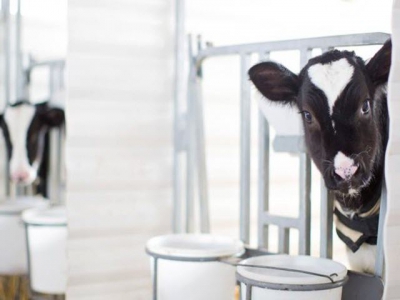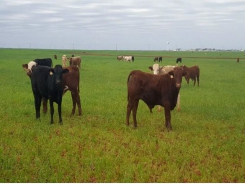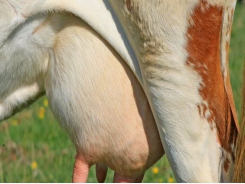Feeding baby calves in winter a chilly proposition

Increase liquid nutrients to help calves keep growing through cold weather.
During the short days and long nights of winter, big changes can happen quickly for baby calves.
“Calves are more susceptible to cold stress than older animals due to their low body fat reserves and larger surface area-to-body mass ratio, which causes them to lose body heat more rapidly,” Skip Olson, technical services veterinarian for Milk Products, explained.
During the first three weeks of life, calves rely almost solely on the milk ration to meet their nutrition needs, according to a news release from the company.
“While young calves have the ability to consume and digest small amounts of starter grain, their energy needs come primarily from the milk ration,” Olson said. “Calves over three weeks of age consume more starter, providing them with more energy to resist cold weather challenges.”
Since baby calves depend on milk for most of their energy needs, it's especially important to adjust the liquid ration for cold conditions. Olson said not doing so can have a snowball effect on young calves.
“Calves can stop gaining and possibly even lose weight,” he noted. “Their immune system can become compromised, leading to health challenges.”
The announcement lists three main ways to adjust the milk ration and help baby calves meet the demands of cold weather:
- Increase the volume fed per day by feeding more often, a larger quantity at each feeding or both.
- Increase the concentration of the milk offered by adding more solids to the existing volume.
- Increase the fat content of the existing milk volume.
“By far, the best method to feed more nutrition is to feed the same diet more frequently during the day,” Olson advised. “Not every farm can adjust to feeding three times per day, but if they can manage to do it for just baby calves, an important need can be met.”
Feeding higher solids, or added fat, to the existing milk increases the total solids fed and may subject baby calves to a higher risk of bloat. Using the National Research Council calf model equations comparing different feeding rates of milk — one with fat added and two with increased volume — the Table shows that a little extra volume goes a long way in meeting the energy needs of a young calf.
Boosting milk replacer feeding rates requires attention to other details to keep calves in balance. Olson offered the following advice for effectively transitioning calves to winter rations:
- Timing. Pick a date in advance of when you are going to change the feeding program in the fall, and stick with it until spring, despite weather fluctuations. One of the worst things you can do to a calf is change the rules.
- Water. Do your best to deliver warm water shortly after milk feeding. Calves will reward your effort by drinking more water, eating more starter grain and continuing to grow during the coldest weather.
- Starter. Even during cold weather, pay close attention to the starter bucket. Make sure the grain is available and palatable to encourage young calves to eat as much as they can.
- Housing. A clean, dry, draft-free environment, with deep bedding and possibly calf jackets, will help calves reserve energy and channel their metabolic efforts toward immune function and growth.
- Milk preparation. Milk prepared for feeding during extremely cold will cool rapidly outdoors. Adjust the initial temperature accordingly to achieve a milk feeding temperature of 100-105°F. Dry milk replacer stored in cold conditions will affect the final feeding temperature when mixed. Adjust warm water accordingly with an accurate thermometer to achieve consistent feeding temperatures.
“Cold weather can be challenging for raising calves, but it doesn't have to make raising healthy calves impossible,” Olson said. "With careful attention to the liquid ration and other surrounding details, many farms successfully raise healthy, well-grown replacements through the most brutal conditions.”
Milk Products, based in Chilton, Wis., manufacturers animal milk replacers and young animal health products, producing more than 700 unique animal nutrition products for independent feed manufacturers, wholesale distributors and large retail chains.
Related news
Tools

Phối trộn thức ăn chăn nuôi

Pha dung dịch thủy canh

Định mức cho tôm ăn

Phối trộn phân bón NPK

Xác định tỷ lệ tôm sống

Chuyển đổi đơn vị phân bón

Xác định công suất sục khí

Chuyển đổi đơn vị tôm

Tính diện tích nhà kính

Tính thể tích ao




 Study measures feed efficiency in forage-, grain-fed cattle
Study measures feed efficiency in forage-, grain-fed cattle  Study to take 'new approach' to mastitis
Study to take 'new approach' to mastitis